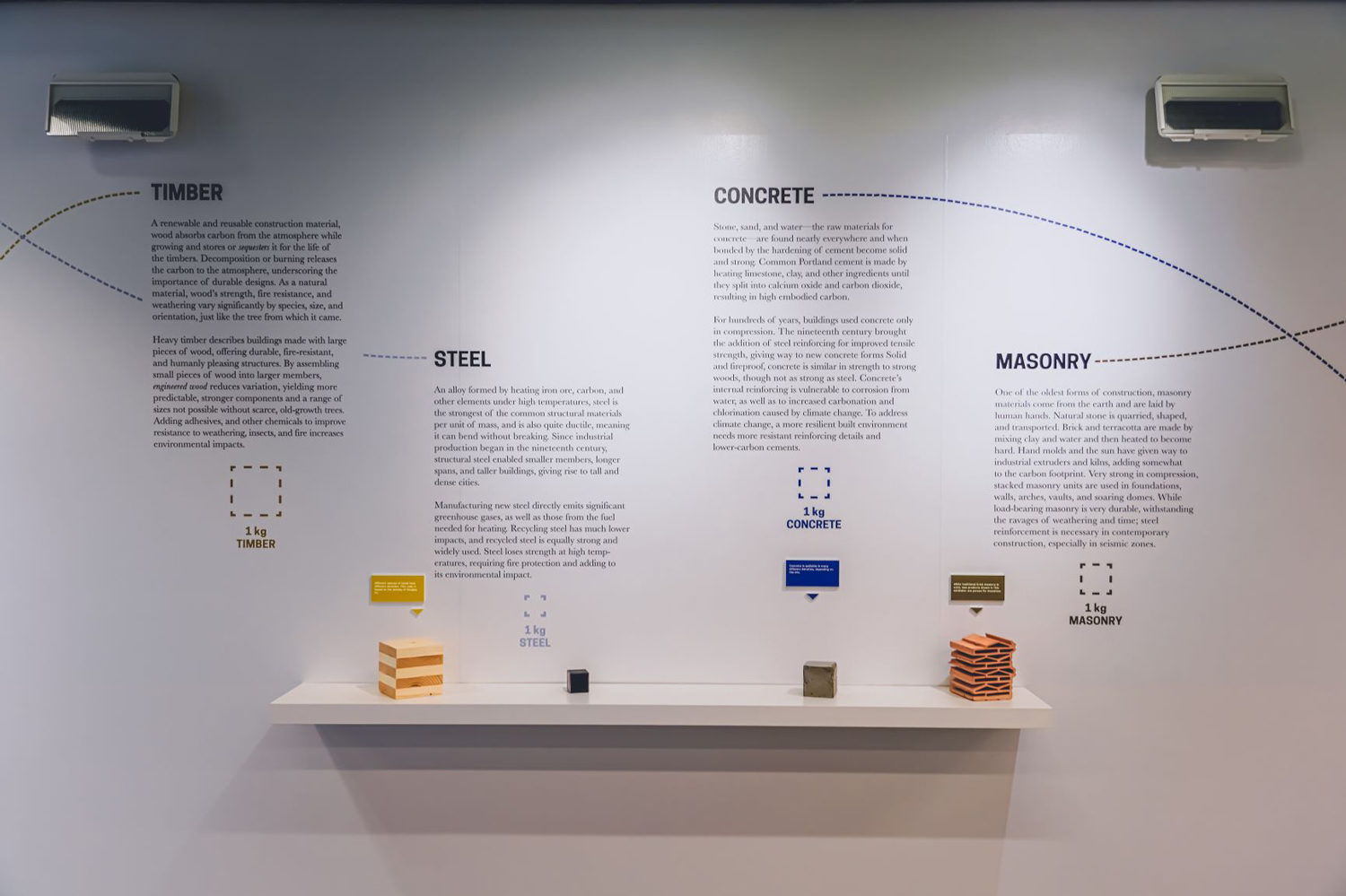Durable Materials
This exhibition uses concrete, steel, masonry, and timber to explore durability, sustainability, and architecture. The physical samples below each contain one kilogram of one of these widely used materials. Although they have the same mass, differences in density result in cubes of different sizes.

One KG Cubes
Curator Michelle Laboy introduces the exhibition and four architectural materials used.
Concrete
Stone, sand, and water—the raw materials for concrete—are found nearly everywhere and when bonded by the hardening of cement become solid and strong. Common Portland cement is made by heating limestone, clay, and other ingredients until they split into calcium oxide and carbon dioxide, resulting in high embodied carbon.
For hundreds of years, buildings used concrete only in compression. The nineteenth century brought the addition of steel reinforcing for improved tensile strength, giving way to new concrete forms Solid and fireproof, concrete is similar in strength to strong woods, though not as strong as steel. Concrete’s internal reinforcing is vulnerable to corrosion from water, as well as to increased carbonation and chlorination caused by climate change. To address climate change, a more resilient built environment needs more resistant reinforcing details and lower-carbon cements.
Explore further in Building Biographies: Research Center ICTA-ICP.
Steel
An alloy formed by heating iron ore, carbon, and other elements under high temperatures, steel is the strongest of the common structural materials per unit of mass, and is also quite ductile, meaning it can bend without breaking. Since industrial production began in the nineteenth century, structural steel enabled smaller members, longer spans, and taller buildings, giving rise to tall and dense cities.
Manufacturing new steel directly emits significant greenhouse gases, as well as those from the fuel needed for heating. Recycling steel has much lower impacts, and recycled steel is equally strong and widely used. Steel loses strength at high temperatures, requiring fire protection and adding to its environmental impact.
Explore further in Building Biographies: United States District Courthouse.
Masonry
One of the oldest forms of construction, masonry materials come from the earth and are laid by human hands. Natural stone is quarried, shaped, and transported. Brick and terracotta are made by mixing clay and water and then heated to become hard. Hand molds and the sun have given way to industrial extruders and kilns, adding somewhat to the carbon footprint. Very strong in compression, stacked masonry units are used in foundations, walls, arches, vaults, and soaring domes. While load-bearing masonry is very durable, withstanding the ravages of weathering and time; steel reinforcement is necessary in contemporary construction, especially in seismic zones.
Explore further in Building Biographies: Haus 2226.
Timber
A renewable and reusable construction material, wood absorbs carbon from the atmosphere while growing and stores or sequesters it for the life of the timbers. Decomposition or burning releases the carbon to the atmosphere, underscoring the importance of durable designs. As a natural material, wood’s strength, fire resistance, and weathering vary significantly by species, size, and orientation, just like the tree from which it came.
Heavy timber describes buildings made with large pieces of wood, offering durable, fire-resistant, and humanly pleasing structures. By assembling small pieces of wood into larger members, engineered wood reduces variation, yielding more predictable, stronger components and a range of sizes not possible without scarce, old-growth trees. Adding adhesives, and other chemicals to improve resistance to weathering, insects, and fire increases environmental impacts.
Explore further in Building Biographies: Wood Innovation and Design Centre.
